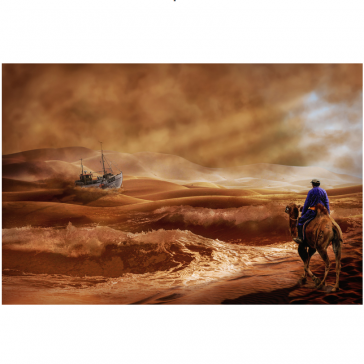SEnECA Blog Post: Horse in North and Ship in South

At the time of the Great Silk Road (138 BC-1492), Europe and Asia were closely connected through terrestrial and maritime routes. In the heyday of this transcontinental trade (VII-IX century), the principle “horses in the North, ships in the South” existed. This principle represented the world’s balance of global trade between the land and the sea parts. Commercial caravans loaded with silk and other luxury items (porcelain, paper, spices etc.) departed from the Chinese mega-city Chang’an (today Xian China) and travelled through the expanses of Central Asia, the Middle East and Asia Minor to the ports of the Black Sea or the Mediterranean. Merchant ships, loaded with silk, porcelain and other necessities, went to sea from the port of Guangzhou (or other Chinese ports), headed through the Malacca Strait to the Indian Ocean and later to the ports of the Persian Gulf or the Red Sea. From there, goods were delivered to the eastern ports of the Mediterranean or the Black Sea by land. From these ports, Byzantine, Venetian and Genoese ships delivered Chinese, Indian or other goods to northern Italy, from where they were distributed throughout Europe.
There was also communication between Asia and Europe through the southern Russian steppes or through the deserts of northern Africa. This was truly the time of a good world trade balance, when horses (camels, to be exact) and ships almost equally divided the assortment of goods transported from the shores of the Pacific Ocean to the shores of the Atlantic Ocean.
By the second half of the 15th century, the Venetian and Genoese ships were expelled from the Black Sea and the eastern Mediterranean and lost their traditional precedence to the Spanish and Portuguese seafarers. In their search for an alternative route to India and China, the Venetian and Genoese ships could not choose the traditional way any more (through the Mediterranean and the Red Sea), but had to enter the world ocean. A new era of great geographical discoveries began with the sea gradually becoming a natural continuation of Europe and with communication on land declining. For several centuries, the seagoing ships monopolized the entire world trade. The horses between Europe and Asia were less and less used to guard trade caravans, but more and more for wars, civil strifes and raids. This state of affairs continued until the end of the twentieth century.
At the end of the last century, one remarkable event occurred: all five Central Asian countries gained independence and the process of nation-building and regional development began. Gradual crystallization of the “regional face” of this youngest region of the world entails enormous opportunities. It can restore the balance of continental trade on sea and on land and firmly connect two parts of extensive Eurasia (from the shores of the Pacific to the shores of the Atlantic Ocean).
The geo-economic advantage of the region (in combination with the South Caucasus) was first realized by Europeans who launched the TRACECA project. Now China is seriously joining in with its “Belt and Road Initiative”. In recent years, the new states of the region have consolidated and are determined to connect Europe and Asia again by numerous means of communication on land. The approaching era of high-speed trains which are able to transport not only passengers, but also commodity containers in the shortest time are also a significant help in this process. Soon, the “iron horses” (trucks and trains) will find their place again in the “North” and a natural tandem with the ships plying in the South of Eurasia will be restored.
I believe that SEnECA will also make a great intellectual contribution to this global trend.
SEnECA Blog Contribution by Dr. Abdugani Mamadazimov from the Center of Sociological Researchers “Zerkalo”
